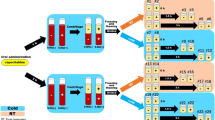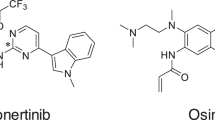Abstract
We studied the effects of 5-ethynyluracil (GW776), a potent inactivator of dihydropyrimidine dehydrogenase, on the metabolism of 5-fluorouracil (5-FU), in particular with respect to formation of the toxic compounds fluoroacetate (FAC) and 2-fluoro-3-hydroxypropionic acid (FHPA), using fluorine-19 nuclear magnetic resonance and the isolated perfused rat liver model. Livers were perfused with 5-FU alone at a dose of 15 mg kg(-1) body weight or with 5-FU + GW776 at doses of 15 mg 5-FU kg(-1) body weight and 0.5 mg GW776 kg(-1) body weight injected 1 h before 5-FU. All 5-FU was metabolized in experiments with 5-FU alone whereas unmetabolized 5-FU represented 94% of the fluorinated compounds measured in experiments with 5-FU + GW776. GW776 modulated both the catabolic and the anabolic pathways of 5-FU, the most striking effect being on the degradative pathway. The amount of 5-FU catabolites decreased by a factor of 27 in the presence of GW776. The modulator led to a decrease in alpha-fluoro-beta-alanine (FBAL) formation by a factor of approximately 110, while fluoride ion formation decreased by a factor of approximately 10. By strongly lowering the metabolism of 5-FU into FBAL, GW776 circumvented the transformation of FBAL into toxic FAC and FHPA. 5-FU anabolites increased by a factor of approximately 7 in the presence of GW776. The level of free fluoronucleotides and 5-fluorouridine-5'-diphosphate sugars was increased up to fivefold. No incorporation of 5-FU into RNA could be measured in experiments with 5-FU alone whereas, although low (0.1% of 5-FU injected dose), it was detectable in experiments with 5-FU + GW776. These results suggest that GW776 may be useful for attenuating the not very common but serious cardiotoxic and/or neurotoxic side-effects of 5-FU that are probably due to FBAL metabolites.
This is a preview of subscription content, access via your institution
Access options
Subscribe to this journal
Receive 24 print issues and online access
$259.00 per year
only $10.79 per issue
Buy this article
- Purchase on Springer Link
- Instant access to full article PDF
Prices may be subject to local taxes which are calculated during checkout
Similar content being viewed by others
Author information
Authors and Affiliations
Rights and permissions
About this article
Cite this article
Arellano, M., Malet-Martino, M., Martino, R. et al. 5-Ethynyluracil (GW776): effects on the formation of the toxic catabolites of 5-fluorouracil, fluoroacetate and fluorohydroxypropionic acid in the isolated perfused rat liver model. Br J Cancer 76, 1170–1180 (1997). https://doi.org/10.1038/bjc.1997.529
Issue Date:
DOI: https://doi.org/10.1038/bjc.1997.529



